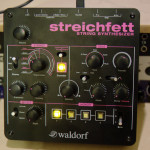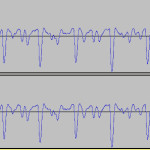Review: Waldorf Streichfett
 With all of the work sorting out the release of Patchwork Cacophony and doing the refit of the studio it felt like time to have a bit of fun. A month or so back I treated myself to a Waldorf Streichfett string synthesizer and so thought I’d dig in and review it a bit.
With all of the work sorting out the release of Patchwork Cacophony and doing the refit of the studio it felt like time to have a bit of fun. A month or so back I treated myself to a Waldorf Streichfett string synthesizer and so thought I’d dig in and review it a bit.
As a little bit of perspective, I’ve been keen on getting my hands on a string synthesizer for a while. I find that I actually get on much better with instruments with limited but strongly defined characters than I do with sonic chameleons. I’ve often though of string synthesizers as a bit like the 70’s, analog synth equivalent of the hammond organ,.both being essentially additive synthesizers of a source but with one using (sort of) sine waves and the other saw waves with an amplitude envelope.
As recently as a year ago I actually started fiddling with the idea of building a digital/analogue hybrid instrument of my own but time (and skills) were in short supply. Then, as if by magic, along came Waldorf with the Streichfett!
Architecture and Features:
There’s enough coverage of the basic facts of this module out there already so I’ll keep it brief: it’s a digital addition to the 70’s analogue string synthesizer family. It’s not an emulation of a specific module, like the Logan or Eminent/Solina, it’s its own entry into the field. String synths were traditional single oscillator divide-down devices which meant that they traded full polyphony for a sound that was essentially a bit weedy. What they did usually have, however, was an “ensemble” effect which was like a chorus on steroids and gave a lush, shimmering colour to the otherwise unimpressive sound.
The Streichfett’s string engine has two different ensemble effects (“strings” and “chorus”) either or both of which may be engaged at the same time. It also has controls for crescendo( attack) and release, a switch to choose between the fundamental pitch, an octave higher, or both, and a “registration” dial which picks the fundamental wave. More on that later.
In addition to the main string synth section it has a very simple eight-note polyphonic synthesizer section with attack/decay or attack/release envelopes and which is confusingly named the “solo” section. It is useful for adding texture and bite to the string sound, and an effects section featuring reverb, and a simple phaser. There’s also an “animate” effect which modulates the registration setting, but conceptually I feel this belongs to the string section.
This is all topped off with a twelve program memory, stereo line and headphone outputs, midi in and out and a USB socket which provides power (from computer or AC adapter) and USB MIDI (but not audio) interfacing.
Basics aside: how is it in use?
When I first got it I noticed quite quickly that there was a crackling in the signal at loud (internal) volumes. Turning down the volume pot didn’t help, but using simpler voices did. Thankfully after upgrading the firmware to version 1.10 this problem seems to have gone away.
A second, and fairly major, gripe I have is that while it has a pretty comprehensive MIDI implementation which exposes all the controls as MIDI CCs, it doesn’t respond to any form of MIDI volume control. This severely limits its usefulness in my setup as not only does it mean it needs to be in physical reach, it means I need a spare hand and can’t, for example, control its volume in tandem with another synth. This is a shame as it sounds absolutely glorious layered with the Prophet 08. Putting a physical volume pedal inline with the audio outs is a partial solution, but it still requires a spare foot to control it and in any case would also mean that the reverb effect was being faded, which isn’t usually what you’d want. Waldorf technical support informed me that this was not something that would be possible for them to implement which is frankly a bit of a cop-out. I hope they reconsider this as it would be trivial to add and would make a huge impact on its useability in a live setting, for example.
There are a couple of other niggles that others have noted which I’m happier to live with. The two ensemble effects are either on or off, rather than continuously variable. It would be nice to fade them in and out, but they’re useful without. It would be good to have some way of allocating one memory slot to “live” mode where the current positions of the dials were used but it doesn’t take that long to go through them setting. Some people have complained that 12 memory slots is mean in this day and age, but I can’t imagine using that many. I’ll probably have a few basic settings for different characters and then tweak them from there. Really there isn’t all that much scope for getting lost with eight dials and four switches (plus three virtual dials for effects, I suppose).
The registration dial is interesting though. Part of me would prefer to have separate faders for each of the waveforms a bit like on the Solina, instead of a single dial which morphs between various settings. That said, the number of voicings that can be generated is more than it first seems, and while there are labeled points showing a various proportions of violin, viola, cello, brass, organ and choir, in fact it’s probably better viewing the registration dial as more of a unique control in its own right, and the heart of what gives the Streichfett its own unique voice. The choir, for example, doesn’t just fade in and out as you pass through its section of the dial, its formants seem to change to give something akin to different vowel sounds.
The (solo) tremolo and phaser and animate settings seem to follow this same principle. Rather than controlling one simple parameter, they seem to vary things in combinations as you turn them. While the results are a musical, the control freaks among us might find that having phaser depth and time tied together is frustrating.
Waveform Oddities:
As I was recording demos for this review I noticed some interesting and unexpected behaviour in the waveforms I was getting, namely that the positive peaks were often much lower than the negative ones. In other words, there seemed to be some very low frequency or DC bias on the waveform. At a couple of points I was fairly sure I was hearing distortion caused by this. Perhaps the 1.10 firmware upgrade didn’t entirely fix the bug I’d noted when I first used it? If so, this is a bit worrying, but it will take some more investigation before I’m sure what’s going on.
So finally, the big question: how does it actually sound?
So far the tone of this review has been mixed, with a few negative observations colouring the overall conclusions. Those gripes aside, how does it actually sound?
Well I think it’s fair to say that treating it as “just” a plain string synthesizer is not playing to its strength. It does have a very usable set of timbres in it and they will probably find their way into future tracks I record as good, useful sounds that sit well in the mix. For the sort of character that will, perhaps, in future years have people saying, “Ah, check out that classic Streichfett sound in there!” it’s the registration morphing and blending in of the eight-part solo section that give it a distinctive voice which might sit more at the front of a mix.
But enough of the words, here are some sounds. First up, sweeping slowly up through the registrations in “base” octave mode, then back down in base + 8va mode.
Now the same thing with the string ensemble mode engaged. As you can here, this is a lot more interesting.
This next sample starts without ensemble, switches on chorus mode, then string mode, then both, then finally ups the reverb and plays a few chords, tweaking the crescendo slightly to give more of a feel of it as an instrument.
String synthesizers are heavily associated with phaser effects. Jean-Michel Jarre’s “Oxygene”is largely an Eminent 310U through a Small Stone phaser. The Streichfett’s built in phase is, for me, a little too inflexible to be particularly useful in a studio setting, but past about ⅔ of the way through the depth knob it stops controlling frequency and instead selects a fixed point. These fixed positions can yield some interesting colour variations to the basic registrations above. Here’s a clip as the phaser is brought in and sped up and then eventually reaches the fixed positions, where I sweep it manually. Note, though, there is distortion as this point is reached, caused by the mid-point offset oddity as mentioned above.
Morphing through the solo (polysynth) section’s five basic sounds, with varying tremolo, with very clicky attack and release settings, and then with varying longer attack:
The twelve presets give a pretty good idea of the breadth of sounds the Streichfett can produce, with quite a bit of scope for ethereal pads as well as string sounds, though they’re all a little too heavily drenched in reverb to be useable in a mix without tweaking — not exactly an unusual feature of factory presets.
And finally a multi-tracked a few sounds together into a simple piece. If I were doing this properly I’d probably skip the on-board reverb and phaser for more control and blend it with some other instruments, but for the sake of the review, this is all Streichfett recorded direct into Ardour with no other processing.
To be added later — I got distracted by investigating the clipping problem and haven’t finished this composition.
Conclusions:
There’s a surprising amount of capability in this box despite its very limited brief. From a relatively small number of controls you can conjure up quite a wide variety of sounds, though they clearly sound closely related. This is something I love in instruments as I find creatively that a defined character is much more inspiring than an unlimited palette.
Some of the instrument’s limitations are characterful, some feel like bit more like missed opportunities and over-simplifications. These two classes really both just make it the Streichfett its own unique tool. There are, however, a few flaws which feel like genuine impediments to its use. The lack of remote volume control is a major oversight in its otherwise flexible MIDI spec, and it pretty much prevents me from using it in my live rig. The worrying tendency for its singal’s centre point to drift downwards and start clipping, which I still haven’t entirely got to the bottom of, would also make me shy away from using it in the studio for anything I wasn’t prepared to listen very closely to and re-record if there were problems.
In the end, I think the Streichfett is a very promising instrument, but ultimately I’m hoping that they produce a version 2 firmware that addresses at least the volume and clipping issues because without that, I think it will remain a fun toy that I never quite trust for serious use.
Edit 2014/12/23:
Having since read up a bit more on this sort of thing, it’s clear that though there’s asymmetry in the waveform, it’s not a DC offset. Furthermore, the asymmetry is not inherently a problem as long as the values are still kept within valid ranges. It does, however, still seem to be the case that somewhere within the Streichfett, before the volume knob, those peak values (almost certainly the negative ones) are exceeding the maximum range and whatever is responsible for bringing them back into range (whether it’s plain digital clipping or some more intelligent limiter) is introducing an audible crackling sound.
|Flattr this!




